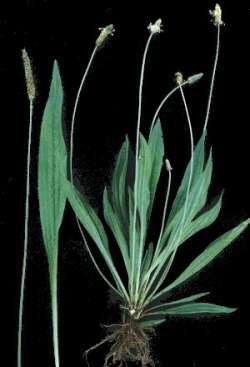|
Gardens Ablaze |
||
|
|
Plantain |
|
|
Additional Plantain Information
Medicinal Uses Site Map
Home |
Growing in sidewalk cracks, along driveways, in waste areas, and, as we all know, in the middle of lawns, Plantain is a tough perennial plant that will tolerate many types of soil and sun levels and will propagate itself freely by dropping seed. Though it prefers full sun, it will still survive and set seed in partially shady locations. A description is hardly necessary, as we have all seen this common roadside plant, but for those who are unsure, Plantain puts out a low-growing basal rosette with leaves that are deeply ribbed, sending up a flower stalk with dense greenish-white flowers, each of which will later become a seedpod. Two main types of Plantain are common in the U.S., including the lance-leafed type as pictured here and the broad-leaved type, which obviously has wider ribbed leaves and basically the same type of flowering habit. Plantain is completely edible (tastes like bitter spinach) and safe for consumption, and can be used in the kitchen for its nutritional value or in the medicine cabinet for its healing properties. Though it is a pest when growing in the middle of a manicured lawn, it can be easily removed using a dandelion digging tool or small hand digger. Be sure to get the entire root when trying to remove it from the lawn, as it has a fibrous taproot that will put out new foliage even if the leaves are cut at ground level. Alternatively, a heavy mulch will shade the plant out if it has become an unwelcome guest in the flower border.
Custom Search
|
|
|
Gardens Ablaze |
||
 There
are two schools of thought in the home gardening world concerning Plantain,
also known as Ribwort. For some, it is an annoying weed that needs
to be eradicated, and for others it is one of the most versatile and accessible
medicinal herbs in the home garden setting.
There
are two schools of thought in the home gardening world concerning Plantain,
also known as Ribwort. For some, it is an annoying weed that needs
to be eradicated, and for others it is one of the most versatile and accessible
medicinal herbs in the home garden setting.